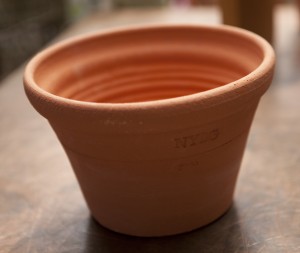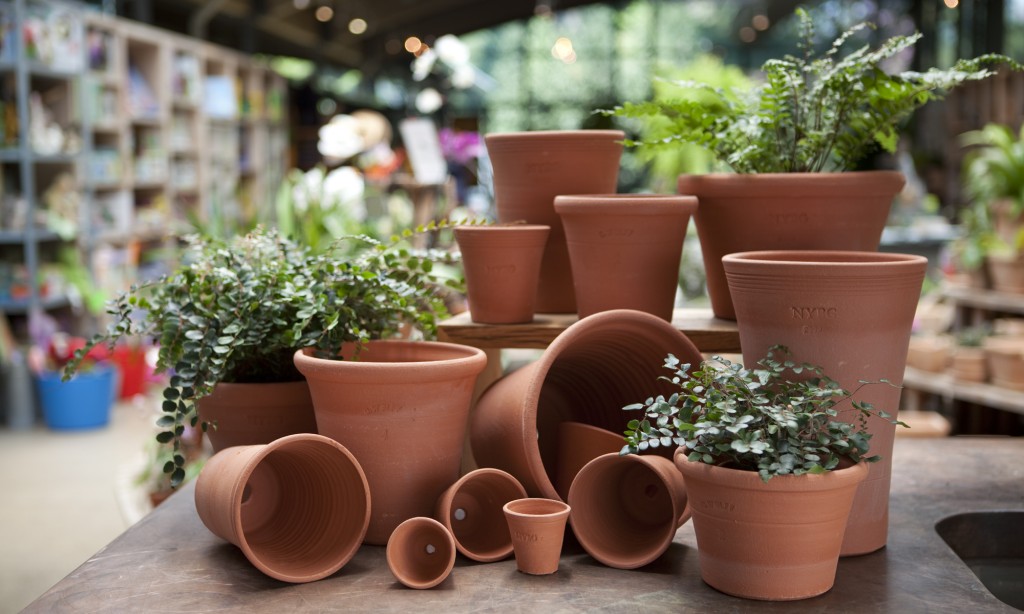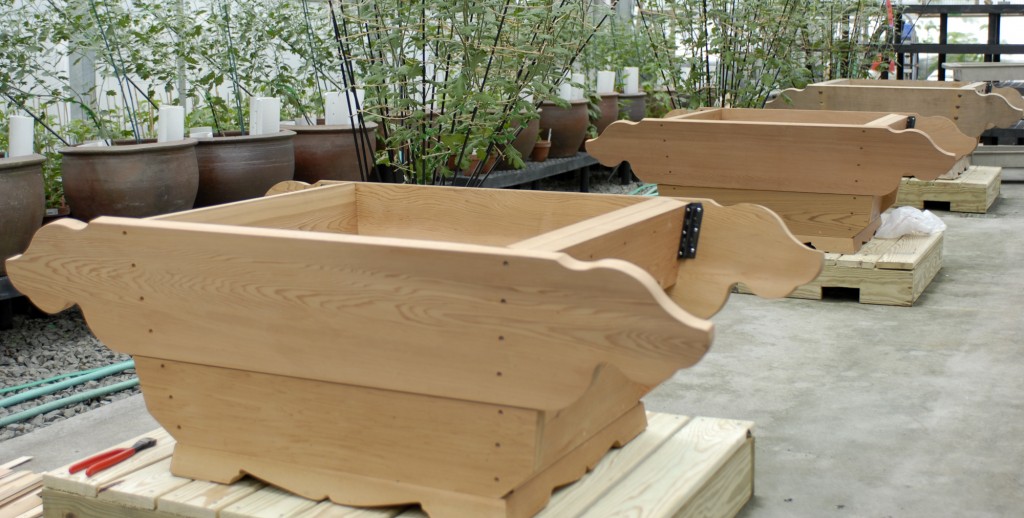Container Madness
Posted in Gardening Tips on April 17 2012, by Sonia Uyterhoeven
 I walked by a restaurant in my neighborhood and realized it was closing down. Large industrial-sized pots, pans, and trays were piled up on display in the window to be sold off for a bargain the next morning. My eye caught a colander in the midst. I stared longingly at the colander and sighed, knowing that I wouldn’t be around when the doors opened for the sale.
I walked by a restaurant in my neighborhood and realized it was closing down. Large industrial-sized pots, pans, and trays were piled up on display in the window to be sold off for a bargain the next morning. My eye caught a colander in the midst. I stared longingly at the colander and sighed, knowing that I wouldn’t be around when the doors opened for the sale.
I love collecting good, sturdy cookware for my own kitchen, but my motives that night were different. The large colander would have made a perfect planting container–perhaps as a hanging basket or a round, squat container that would have added an elegant touch to an intimate terrace garden. Unlike the small ones that I buy at retail stores for draining my pasta, this industrial colander was about 16 to 18 inches in diameter. It was crying out for a collection of herbs, sedums, hens and chicks, strawberries or colorful cascading annuals. It even could have become a home to mesclun mix.
There are many ways to get creative with containers. Some are more durable than others; some are just for seasonal fun. Several years ago I made several containers in early spring with some leftover Easter baskets that I found in my store cabinet. I lined the pretty woven baskets with dark colored, heavy duty garbage bags cut to size. I wove the two layers together with flexible florist wire, and slits were cut in the bottom of the garbage bags to allow for drainage. To help preserve the integrity of the basket, you can place a felt hanging basket liner on top of the plastic, but this is not necessary. I added a free-draining potting mix and filled the baskets with spring bulbs, pansies, scented geraniums and herbs. The basket will weather and suffer from wear and tear, but it made a wonderful seasonal decorative container.
There are many fun containers that you can recycle and reuse from items found in your home. Sometimes colorful plastic tubs or an old beach pail makes a festive statement. Remember that you will always have to drill drainage holes in the bottom, or if drainage seems like it will be a problem (as it can be for large whiskey barrels), also add a few holes on the side of the container near the bottom.
If you are not a “do-it-yourselfer,” then there is a wide variety of pots available on the market these days for reasonable prices. Shop around a bit to find pots that express your personality, or those that lie in tandem with your gardening style.
Every material has its pros and cons. Fiberglass and polyresin containers (different types of synthetic containers) tend to be highly weather-proof, light, and range from moderate to inexpensive in price. They come in an array of styles and colors that often mimic natural materials, such as stone, cast iron, and terra cotta.

Terra cotta is a stalwart of the container world. It is porous, allowing for excellent drainage; it is versatile; and is nice and heavy, so it will not topple over during a wind storm or heavy rain. It is also fragile and is not reliably frost-proof (even if it makes the claim), so it should be taken in during the winter. During the growing season, terra cotta handles temperature fluctuations like a pro, and will act like a protective buffer for dramatic changes from hot to cold.
Metal containers are very trendy and chic looking but they can really heat up during the day. Southern gardeners need to proceed with caution and place galvanized buckets in areas with afternoon shade. Keeping the container well-watered is another strategy for keeping the root systems cool. Wood containers are more forgiving for temperature changes. It is important not to have a wooden container sitting directly on the ground where it is damp. This will accelerate the rotting process. Paint or stain wooden containers with a non-toxic paint or wood preservative to prevent rot.
In general, dark colored containers will absorb more heat from the sun during the summer, so you need to keep them well watered and place them out of intense afternoon sun in southern climates. Due to evaporation, porous, breathable material such as terra cotta will require more water than plastic containers. Likewise, shallow containers will require more water than deep containers.
In terms of the size of your container, if you are intending to have just one specimen plant in a pot then the container should be four inches wider than the nursery pot. If you are designing a mixed container, provide enough width that the plants fit comfortably in the pot. You will be placing your annuals and perennials much closer together in a container than you would be in the garden, but they still need room to sit comfortably with each other and grow.

Generally, for large containers, I like to use those that are 14 inches and wider for a nice display. And height is just as important as width in a container. Some of your container candidates, such as annuals and some perennials, will be fine with shallow pots. However, plants with deep root systems or plants that need good anchorage and space should be grown in deeper pots (18 inches is often the recommended depth).
Your plants and the container should have the same visual weight so that everything looks like it’s in proportion. Sometimes contrasting shapes and sizes looks interesting, but be sure to stand back and see how everything looks. Having a short, round plant in a squatty container generally looks good, while having a short, rounded plant in a tall and narrow container looks out of place unless the plant cascades down the sides of the container. Look around at other people’s containers and see what catches your eye.
The general convention is to make a combination of what people in the trade are referring to as thrillers, fillers, and spillers; a combination of height and impact, something to add fullness, and something to cascade over the edge, blurring the boundaries of the containers. This recipe works effectively with graduated heights and produces a nice balanced display. Don’t be afraid to shake it up and try something new–designing a container is an individual task that should celebrate your garden’s personality.

